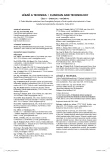Resonance methods of measurement viscoelasticity of biological structures
Authors:
Stanislav Ďoubal; Petr Klemera; Monika Kuchařová
Authors‘ workplace:
Katedra biofyziky a fyzikální chemie, Farmaceutická fakulta University Karlovy, Hradec Králové
Published in:
Lékař a technika - Clinician and Technology No. 1, 2012, 42, 33-38
Overview
Dynamic loading is typical for most biological structures. Consequently, mechanical behavior of biological structures cannot be fully described by static parameters and characteristics. Changes in deformation lead to energy losses, furthermore, energy losses are result of existence of viscose constituents in mechanical behavior in biological materials. Bodies in which losses of energy are not negligible belong to category of so called viscoleastic bodies. Viscoelasticity is property of bodies or material that exhibits both viscous and elastic behavior when deformed.
From the mathematical point of view, relationships between stresses and strains may be described by adequate differential equation. More practical approach is based on rheological models or, more recently, on determination of complex modules of elasticity, complex dynamic stiffness and mechanical impedance.
Availability of applicable methodology of measurement of viscoelasticity is essential for quantification of mechanical behavior of viscoelastic bodies. At present, methodology DMA (dynamic mechanical analysis) is applied for measurement of viscoelasticity in industry. The DMA is based on measurement of mechanical frequency characteristics. Methods based on RMA (resonance mechanical analysis) are designated for measurements in biomechanical and biomedical laboratories.
Key words:
Viscoelasticity; measurement; complex moduli; mechanical impedance;
Sources
[1] Manas Chanda and Salil K . Roy: Plastics Technology Handbook, Fourth Edition.
CRC Press, Boca Raton, 2007.
[2] Stanislav Ďoubal a kol.: Mechanické chování viskoelastických těles, teorie a měření, Karolinum, Praha, 2011.
[3] Ďoubal, S., Klemera, P., Lamka, J., Semecký, V., Kuchařová, M.: Dynamika deformační reakce cévních stěn na mechanické zatížení – metodika měření in vitro, lineární a nelineární modely, Lékař a technika, 6, 35, (2004), pp. 135-141.
[4] Kuchařová, M., Ďoubal, S., Klemera, P., Rejchrt, P., Navrátil, M.: Viscoelasticity of Biological Materials – Measurement and Practical Impact on Biomedicine, Physiol. Res. 56 (Suppl. 1), (2007), pp. S33-S37.
[5] Doubal, S., Klemera, P., Kucharova, M., Rejchrt, P.: A New Approach to Measurement of Viscoelastic Parameters of Biological Structures, Proceedings of Second Fascia Research Congress, Vrije Universiteit, Amsterdam, 2009, p. 105.
Labels
BiomedicineArticle was published in
The Clinician and Technology Journal

2012 Issue 1
Most read in this issue
- Intrakraniální tlak a jeho identifikační možnosti při léčbě kraniocerebrálního poranění
- Assessment of suitability of Excimer laser in treating onychomycosis
- Biophysical principles of photoacoustic tomography
- Resonance methods of measurement viscoelasticity of biological structures
